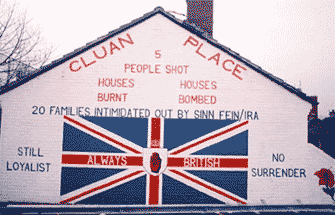|
Victims:
THE STORY OF UNIONISTS “LIVING” AT THE
INTERFACE WITH REPUBLICAN SHORT STRAND
BY PETER ROBINSON MP MLA
insight NOVEMBER 2002

1: Setting the Scene
One of the characteristics of the republican movement in
recent times has been the way, while agitating and
orchestrating violence at interface areas across Belfast, they
have, in parallel, fought a fierce and vile propaganda war.
The Provos launch attacks, wait for reprisals and castigate
loyalists for attacking innocent Catholics. They can usually
rely on a lazy and, in some cases, partisan media not to
investigate and simply take refuge in blaming both sides.
At the very least they can expect to cloud the issue of
where blame lies for the initiation of hostilities.
The result of this wheeze saw Short Strand republicans don themselves
in the robes
of righteous victimhood even before the sirens of the ambulances,carrying
the
Protestants they had shot, had faded in the night air. While Protestants
fought for
their lives in hospital, Sinn Fein/IRA were undertaking a propaganda campaign
to
smear them and elevate republican perpetrators of the trouble to victim
status.
This account, unapologetically, sets out to put the record straight. It
is essential that
the unionist case - one which is not always heard - be told. We owe it
to the victims
of the violence to provide a greater understanding of events in this area.
The people
of Cluan Place, Madrid Street, Thistle Court and elsewhere along the Short
Strand
interface deserve no less.
insight NOVEMBER 2002
2: The Location
Most local communities are delineated by geographical factors and infrastructural
features.The main arterial routes around this district create natural
boundaries which
encompass Short Strand, Cluan Place, Thistle Court and the adjoining streets.
While
in most circumstances this naturally carved district might have formed
a homogenous
community, the diametrically opposing political ideology within its borders
and the
presence of the IRA who are willing to kill, injure and inflict damage
on those who
do not share their opinions, has created a deeply divided district. The
immediate
area is overwhelmingly nationalist but it is abutting the overwhelmingly
unionist East
Belfast. This has produced what, in Northern Ireland, is known as the
sectarian
interface.
Cluan Place is an isolated Unionist area backing on to the republican
Short Strand. It
is a street of 25 houses. Each home has been attacked at one time or another
while
some have been attacked on many occasions. Cluan Place sits between Short
Strand
and the Albertbridge Road.
Thistle Court and Madrid Street, until very recently was completely exposed
to
republican Short Strand and suffered drastically as a consequence. More
than 40 out
of 79 houses sit derelict in the Thistle Court/ Madrid Street area as
a result of IRA
attacks. After pleas to Government, gates eventually were erected across
Madrid
Street beside Thistle Court, stopping republican incursions but the missiles
continue.
The interface also stretches along Duke Street, Susan Street and the lower
Newtownards Road. The main focus of republican aggression for many years
was at
Thistle Court/Madrid Street, though every other part of the interface
received a
portion of the violence. The attacks along the boundary with Short Strand
have
ranged from comparative low-level stone-throwing by children, especially
during
school holiday periods (disturbingly referred to as recreational violence),
through
street riots, up to full-scale assaults including the use of guns, petrol
bombs and
blast bombs. This has been the tribulation suffered by too many for too
long.
A detectable shift in republican tactics took place after the erection
of the Madrid
Street security gates. Republicans directed their violent operations principally
against
Cluan Place. As Madrid Street/Thistle Court became harder to directly
attack the IRA
sought out the new most vulnerable target.
insight NOVEMBER 2002
3: History of Conflict
Violence emanating from Short Strand goes back several decades. Precisely
thirty
years before the present shootings the St Matthew's massacre took place
when IRA
gunmen rained gunfire down into the Newtownards Road, murdering three
people
and injuring five others. The IRA murderers positioned in the Chapel steeple
shot
indiscriminately at Protestants in the road below.
For the past quarter of a century, during which I have represented East
Belfast in
Parliament, I have been involved in dealing with the impact of attacks
on Madrid
Street and Thistle Court where Republicans repeatedly launched attacks
on Protestant
homes, burning them down, destroying the fabric of the area and forcing
Protestants
out. The evidence of this campaign of "ethnic cleansing" is
all around and visibly
evident.
After years of lobbying on behalf of unionist residents, who only wanted
to live in
peace, the Government erected gates across Madrid Street separating republicans
in
Short Strand from their unionist neighbours and, at last, offering a degree
of
protection to unionists who have been the victims of a coordinated and
sustained
campaign to drive them out.
4: Tourists and others attacked
It is not only East Belfast's unionist residents who have suffered from
republican
violence in this area. Last year three young Australian tourists were
attacked and
beaten in the Short Strand area by a republican gang carrying iron bars.
The men were walking on the Albertbridge Road in the direction of Woodstock
Link
when they were set upon by a republican gang of up to 20 from Short Strand.
One
of the men fell to the ground and he was then dragged into an entry where
the
gang continued to beat him. His two friends eventually rescued him and
all three
escaped. The police said it was a terrible attack which was completely
unprovoked.
It is not just foreign tourists who have been attacked travelling near
Short Strand.
Within the past twelve months around 30 beatings have been carried out
by "snatch
squads" from within Short Strand against people coming home from
the City Centre
or travelling around East Belfast.
One case in particular resulted in a pedestrian being left with a punctured
lung.
People walking along the Albertbridge Road from Castlereagh Street or
the
Woodstock Road take the risk of being stoned or attacked.
insight NOVEMBER 2002
Cyclically, Orange parades along the Newtownards Road are attacked by
nationalists
as they seek to whip up conflict at the interface.
On a regular basis people standing on the green at Mountpottinger Road
damage
cars. This has had an impact on those who do not have access to private
transport
who cannot apply for jobs that require shift work in the City Centre.
It also restricts
access to the social life of the City centre and creates fear and alienation
in the area.
There has also been an adverse impact on children who have to travel into
the centre
of town to get a connecting bus to school. Indeed some parents have to
periodically
stop sending their children to school until their safety can be guaranteed.
5: The Republican Agenda
Conflicts, such as those around areas like Short Strand, do not happen
by accident.
They have been carefully created and manipulated by republicans. Having
it the blue
touch paper they retreat into their own areas, leaving behind a trail
of destruction
and having triggered a cycle of tit-for-tat retaliations. In order to
properly understand
the current violence it is important to understand the republican mentality
which
brought about the present situation.
There are a number of reasons for the present outbreak:
- UNDERMINE THE POLICE SERVICE
Republicans will use any device as ammunition in the battle over policing.
It is
clearly the intention of republicans to create a situation which will
draw the police
into nationalist areas and into conflict with the local population. In
such a tense
situation republicans intent on violence will seek to exploit any attempt
to restore
order by the police. As a result republicans will attempt to police their
own areas
and make them no-go areas for the police.
- KEEP VOLUNTEERS BUSY
It is critical to the Sinn Fein/IRA twin-track approach that they have
volunteers who
are available, when required, to intensify the pressure on the British
Government.
The Provos therefore find it useful to orchestrate incidents to keep the
volunteers
busy and ensure they do not drift away from the Organisation.
insight NOVEMBER 2002
- CREATE NEW VICTIMS
Central to the entire ideology of Irish republicanism is the notion of
victimhood. This
is a characteristic which goes back centuries but is used by modern day
republicans
to first create and then exploit 'victims'. With the Holy Cross children
fading from the
media's eye it was necessary that another set of victims be created to
take their
place.
- TERRITORIAL EXPANSION
The expansion of republican communities into unionist areas by intimidating
neighbouring Protestants has been a feature of the thirty years of the
troubles. It is
clear that in this area there is a desire to extend the boundaries of
republican control
out to the Albertbridge Road on one side and Templemore Avenue on the
other. This
will have the consequence of increasing the chance of republican elected
representation.
- ANTI-PARADES PROGRAMME
Causing violence at the edge of areas where Orange and other Loyal Orders
parade
has been a key feature of republican strategy for many years. With the
Newtownards Road and Albertbridge Road both being used for parades, republicans
cause strife to fuel the fire. The attempt to expand towards Albertbridge
Road and
Templemore Avenue also has the objective of having a republican interface
with the
main meeting place for East Belfast Orange events and would ultimately
threaten
traditional Orange parades in the area.
- CAUSE NATIONALIST RELIANCE ON IRA
Creating fear within the nationalist community follows from the predictable
loyalist
reprisals and ironically has the beneficial effect (for the IRA) of making
nationalists,
living in Short Strand, turn to the Provos for protection from the violence
it initiated.
- JUSTIFY NO DECOMMISSIONING
A community that lives in a climate of tension is likely to be less demanding
on the
IRA to decommission its illegal stockpile of weapons.
In short there are many advantages for the IRA in maintaining the violence
in this
area.
insight NOVEMBER 2002
6: The IRA’s Tactics
The pattern of republican action is always to stir up unrest, offer dialogue
as a
diversionary tactic, then attack loyalist areas before withdrawing to
manipulate the
media coverage of the Interface. Having planned the acts of aggression
they unfold
their prepared propaganda offensive and have it up and running while the
poor
Protestants are still reeling from the violent attack. A lazy press takes
the message
thrust at them and feels that they must give balance to the story they
report. Even
when Protestants have been shot, or Protestant homes destroyed, the same
level of
coverage will be given to the republican falsehoods.
Having dressed themselves in victims' garb, the republican aggressors
maintain a
steady level of attrition so that decent people living under their violence
cannot
enjoy any peace or safety and, for the sake of their families, are forced
to seek
alternative housing outside the area. Often republicans from other parts
of Belfast,
and beyond, are bussed into the area to maintain the level of attrition.
The accompanying news coverage of unionists fleeing the area is then used
to cause
blight on the district, dissuading any other unionist from accepting the
offer of
accommodation no matter how desperately they need a house.
7: The Facts
The picture tells the story. This is Cluan Place. Houses destroyed by
republican
attacks. Residents forced out - the street left derelict and deserted.
Even a passing
visit to Cluan Place (before its residents were driven away from it by
their
republican neighbours) demonstrated that there was a sense of neighbourhood
-
so often absent in this generation. Doors were left open for "the
street to drop in".
There was closeness, a friendship and a regular contact between neighbours
that,
while it was the norm of yesterday's Belfast, is scarce in today's social
order.
The scale, consistency and escalation of violence at this interface can
be seen by
these Police statistics.
Members of the Inner East Belfast Forum have meticulously recorded the
incidents
during the month of June 2002 (at the time of this publication going to
press the
police statistics were not available).
insight NOVEMBER 2002
Another key indicator of who the real victims are is the level of homelessness
- and
which community has been made homeless.
Yet another test of the direction of the violence is the fact that 5 Protestants
were
shot, several seriously. One of the men shot, twice - once in the back
and once in
the ankle - had received a peace prize from the Secretary of State only
a week
before. He was in the area to help young people he was working with get
away
from danger. Two other young men were shot while boarding up the windows
of
houses attacked by republicans. As well as those shot by the IRA from
Short Strand
there have been several near misses. One man, sitting in his living room,
had a
bullet fly past him and embed in the wall behind. No Short Strand residents
were
shot.
On the eve of the 12th July police seized potentially lethal items from
Short Strand.
Just before the main loyalist parade in the area the police discovered
eight crates of
bottles to be used for petrol bombing the parade. Along with the bottles
were a
large bag of nuts, bolts and lead weights to be used as missiles. A similar
discovery
was made in North Belfast hours before the Orange parade in that area
took place.
Yet statistics seem woefully inadequate in quantifying the impact of the
constant
violence on residents. The scene in Cluan Place is one of devastation.
Every house
has its windows boarded up while the backs of the houses bordering the
peace wall
are virtually destroyed. Most roofs have gaping holes in them and there
is debris
everywhere. The streets and walls show the marks of terror. Petrol bombs
and
paint bombs have left an unattractive but indelible imprint on the area.
The scene is
all too familiar, having been the pattern experienced by Thistle Court
and Madrid
Street previously.
However, it is the Street's inhabitants that have suffered most. As one
resident put
it, "The worst thing is living in constant fear. You never know when
the next attack
will come. Even in-between you can't get away from the tension. We try
to sleep
INCIDENTS Cluan Place Thistle Court
Attempted murder 5 0
Attacks using Petrol bombs 24 6
Attacks using fireworks with nails attached 11 8
Attacks using Blast bombs 7 3
Attacks using stones, bricks, bottles and other missiles 72 47
Attacks using pebbles etc. from catapults 38 20
insight NOVEMBER 2002
downstairs. We don't dare go to bed. Every noise strikes fear."
Roy Garland, writing in the Irish News, reports: -
"I went into what remained of the home of a young family who told
me that
during the worst violence they were awakened to the sound of breaking
glass.
Windows and slates were smashed with bricks, paint tins and other missiles
from Clandeboye Drive. Petrol bombs also penetrated the working kitchen
leaving telltale scorch marks on the cupboards.
I became conscious of a child's quiet but insistent voice. I looked down
and she
was holding out her hands saying, 'They're still shaking'. She tried to
explain,
'I've been getting out of bed and mummy comes to me. I stayed to mind
my
dog. I was in here, when all the glass blew in.' The child helped her
mum clean
up the mess and said a man on the wall shouted, 'Orange Bs', her dad added
that they yelled, 'We'll bum youse out of your Protestant enclaves'.
The child's dad and his brother were shot at as they ran to protect another
house under attack. Mum recalls seeing flashes from the muzzles of republican
guns in the darkness. Dad said at that point there was nothing they could
do -
they just froze. In all five people were shot.'
In the Irish Times Monika Unsworth shared my own experience of the difference
between life in Cluan Place and Short Strand. Referring to nationalist
Clandeboye
Drive she writes: -
“…the atmosphere seems very different. There is no graffiti,
most houses have
colourful hanging baskets and people stand chatting in the street. The
Short
Strand Community Centre, a bright modem complex two streets from
Clandeboye Drive offers everything from mother toddler groups to drug
awareness classes and an after school club."
Recently I toured Short Strand with Social Development Minister, Nigel
Dodds, before
visiting Cluan Place. As we toured Short Strand we saw children playing
in the
streets and residents' cars parked outside their homes without any concern
that they
would be damaged. There was a relaxed atmosphere evident. We saw that
all the
houses in the area had the appearance of being occupied and there was
no sign of
devastation. The very reverse was the picture in Cluan Place. The Minister
left
without any doubt in his mind which community was under attack and which
was
the aggressor.
insight NOVEMBER 2002
8: Reprisals
It is as inevitable as it is regrettable that once attacks have taken
place against any
community then reprisals occur. The major difference in this pattern is
the reaction
of the leaders of the two communities.
Take as an example the intrusion into the nearby College by angry women
and
youths who sought to distinguish republicans by administering the "H"
test, and
telling those who failed that they were not welcome. Unionist leaders
roundly,
immediately and publicly condemned the threat, even to the extent of speaking
on
the matter in the Northern Ireland Assembly. Every local unionist Assembly
Member
spoke out. Compare the unionist politicians condemnation of violence and
threats
with Sinn Fein/IRA’s Councillor in Short Strand, Joe O'Donnell, who
consistently
blames everyone else - loyalists, the police, etc. rather than admitting
republican
responsibility for any violence.
Unionist leaders will continue to urge non-retaliation and calm and will,
without any
reservation, condemn those who take the law into their own hands - even
in
circumstances where they have suffered from republican aggression. Nonetheless,
unionist leaders will continue to draw attention to, and highlight, the
source and
cause of the violence. However, unionist politicians from all parties,
as well as
community and church leaders in the unionist community, equally expect
the police
to apply the full rigor of law enforcement to the instigators of the violence.
Sadly
this has not been happening.
9: Policing the Interface
In more recent weeks there has been a virtual constant presence in Cluan
Place
affording a measure of protection to the residents. The police and Army
in the area
have been subjected to many attacks. One outrageous attack is believed
to have
come from "loyalists". There has been much criticism of the
police operation in the
area and, in particular, the failure to have the same deployment on both
sides of the
divide. The East Belfast Assembly Member, Sam Wilson, who is also a member
of
the Northern Ireland Police Board, faced the Police Chief with this issue
claiming: -
"Not only has there been a consistent refusal on the part of the
police to deploy
in Short Strand but the police even refused to permit the Army to go into
the
Clandeboye estate in Short Strand to disperse a crowd of several hundred
republicans who had just petrol bombed a unionist resident's home in Cluan
Place and were continuing to stone and petrol bomb others in the street."
No static presence exists on the republican side of the boundary. Both
the police
and the Army are permanently sited in Cluan Place. The absence of an on
the
insight NOVEMBER 2002
ground presence in Short Strand allows the IRA freedom to launch attacks
undetected. Operationally this strategy makes no sense. It is for the
most part
politically motivated.
Repeated calls for the police to go into Short Strand and face down the
mobs, who
were attacking Cluan Place or Thistle Court, fell on deaf ears. Policemen
have
informed the author of their frustration at being told by police chiefs
that they were
not to go into Short Strand except on precise orders and always in armoured
vehicles
which are not permitted to stop. This is always passed on with the warning
that
republicans are trying to engage the police in the area and the decisions
have been
taken for "operational reasons". However, most unionists believe
that no small part
of the police strategy is because local police chiefs have been attempting
to build up
a relationship with the local Sinn Fein/IRA representative, Joe O'Donnell,
and many
contend that operational decisions reflect the desire to keep O'Donnell
"sweet".
Along with unionist elected representatives for the area - Sir Reg Empey,
Ian
Adamson and David Ervine - I met with the Acting Chief Constable about
the police
response to republican violence. During the meeting we pointed out that
when, the
previous weekend, republicans had destroyed a unionist home in Cluan Place
in a
petrol bombing, the police Press Office had briefed the media that the
violence had
come from "both sides". Yet the Incidents Log in the local police
station shows that
the violence came from republican Short Strand. The Acting Chief Constable
openly
admitted to us that his records showed republicans to have been responsible
but he
could not tell us by whom, or why the truth had been skewed.
10: War
When running a propaganda campaign that has no regard to facts, there
is seldom
a difficulty in rebutting any and all accusations. If you are prepared
to resort to lies
then any excuse will do. The lies will, over time, wear thin and, from
time to time,
will be exposed. The Northern Ireland Housing Executive statistics demonstrate
the
falsehoods that Sinn Fein/IRA has been propagating about the number of
houses in
Short Strand damaged and the number of residents declared homeless. Local
churchmen and community leaders have been present during republican attacks
and
have expressed outrage when afterwards the media reported Sinn Fein/IRA
claims
that loyalists were to blame.
Republicans in Short Strand have no embarrassment about the extent of
the lies they
tell. One even had the audacity to suggest that republicans had not been
involved
in any stone throwing. "We have not as much as dropped a cigarette
paper", he
said. Just take a look at the devastation in Cluan Place and read that
quote again.
The republican document 'Short Strand Under Siege', produced as part of
its victim
strategy, is a classic case of vile propaganda. It is a combination of
half-truths,
insight NOVEMBER 2002
deliberate lies and colossal distortions, concocted to create a perception
of a
situation for which loyalists have been entirely responsible. A combination
of
unsubstantiated and unsustainable claims set against a background of
misinformation, characterise the document. Further reference to the republican
publication would merely give it a legitimacy which it does not deserve.
It is
sufficient to say that Police records do not support the claims made by
republicans.
Yet, even if this was not so, only a fleeting visit to the area would
demonstrate the
truth. The burnt out shells of houses torched by republicans, the damaged
homes
and, worse, the injured unionists shot or stoned by Provo activists tell
a tale that IRA
propaganda cannot erase or refute. The trail of republican aggression
is
unmistakable and needs no other voice.
Apart from the ritualistic Joe O'Donnell denials, the main device republicans
have
used in an attempt to prop up their spurious claims was to advance the
claim that
they are a tiny Catholic community surrounded by a massive Protestant
force. They
then pose the question, "Would any sane person think that from this
weak and
defenseless position we would be instigating attacks on such a numerically
superior
group?"
It is easy to illustrate the nature of the deceit of this David and Goliath
scenario. By
any standards it is a claim which is deliberately intended to delude.
The reality is
that the nationalist Markets and Lower Ormeau area is much closer to Short
Strand
than Stormont or Bloomfield. Indeed the Falls Road is closer to Short
Strand than
the parts of east Belfast that would have to be reached in order to find
the 60,000
Protestant Unionists the republicans claim. Ballymurphy is closer to Short
Strand
than Ballybeen is to Cluan Place.
Lindy McDowell, writing in the Belfast Telegraph, touched upon this issue:
-
"Republicans not only recognise the need to get their story across
but to distil it
into one simple message. A fine example of this is there publican line
on who
is to blame for the current trouble in East Belfast. A cartoon wall mural
suggests that nobody in Short Strand can possibly bear any blame. Short
Strand is portrayed as gusty ' little David (population 3000) taking on
the
monstrous Goliath of East Belfast (population 60, 000)…”
She concludes: -
"Five people including two 15-year-old boys were shot in one little
street, Cluan
Place, by a gunman operating from Short Strand. So who was the David and
Goliath there?"
In electoral terms Short Strand falls within the Ballymacarrett Ward,
which has a
population of about 4900, indicating, on the evidence supplied by the
republican
document, that there is a significant nationalist majority in this area.
It is, of course,
insight NOVEMBER 2002
Cluan Place, which is sitting on a limb, completely isolated from the
rest of the
Protestant Unionist streets in the Ward and vulnerable to the constant
threat from
the Short Strand area which directly adjoins this small, helpless, exposed
and rapidly
diminishing Protestant/unionist community. In any other country the Press
and
Media would call it what it is - ethnic cleansing.
11: The Last Word... for Now
One of the problems of writing an account such as this is the pace at
which events
move. Yet no matter what follows this account, the seeds of what may come
has
been sown in the behaviour of the past. Now here in this account do I
rely on the
notion that each and every evil deed has been perpetrated by one side
alone upon
the other. Rather I advance the certainty, which I sincerely hold, that
the IRA has
been, and is, orchestrating violence and seeking to provoke a response
from
loyalists.
When, along with community leaders, churchmen, and residents, I met the
Security
Minister I urged that a reliable CCTV system be erected to identify the
source of
violence and, if possible, those responsible. Again, this was a plea the
group of
politicians made to the Acting Chief Constable. After the meeting Sir
Reg said, "Let
the police tell it as it is. If loyalists are responsible, say so. If
republicans are to
blame then say so." This is not a worthless point. If the blame is
clearly attached to
those responsible then republicans will find no profit in the war of attrition.
Their
cultural victimhood would not be indulged and the exercise would become
counterproductive.
But the political imperative for the NIO is to ensure that the failed
and
faltering peace process is not tarnished by an admission that "the
Provos are at it".
Central to the interface problem has been the failure of the Government
to declare
that the IRA is in default of their ceasefire. If the Provos are permitted
to be a part
of government and still keep an active terrorist outfit, they will continue
to do it.
The Government has, for political reasons, failed in its duty to the people
of Northern
Ireland by not setting out and enforcing sanctions against the IRA for
the many
breaches of its so-called ceasefire. Unionists living on the interface
with republican
Short Strand have been paying the price.
The Northern Ireland Office must complete the security defences that residents
sought from Security Minister, Jane Kennedy - lives depend on it. On two
occasions,
during the height of recent violence, sincere and assiduously active community
and
church leaders in the unionist area brokered agreements with loyalist
paramilitaries
to gain support for a way forward to end violence and reprisals. On both
occasions
the loyalist paramilitaries supported these agreements. The way forward
was
communicated to the Short Strand community who assured the unionist community
and church leaders that this was considered as a positive step. Within
24 hours of
both messages having been passed on to Short Strand, rather than reciprocating
the
unionist community's initiative, republicans launched fierce and brutal
attacks on
their unionist neighbours.
It is essential that people on both sides of the divide be allowed to
live their lives in
peace. This is the central and collective goal of all the East Belfast
Assembly
Members. Along with the Inner East Belfast Forum we are dedicated to work
towards this end. A more honest understanding of the circumstances can
only aid
this outcome.
Unionists in Cluan Place, Thistle Court and Madrid
Street need to know that their dilemma is
understood and that they have the support of the
wider unionist community. This publication is an act
of solidarity with them.
|







